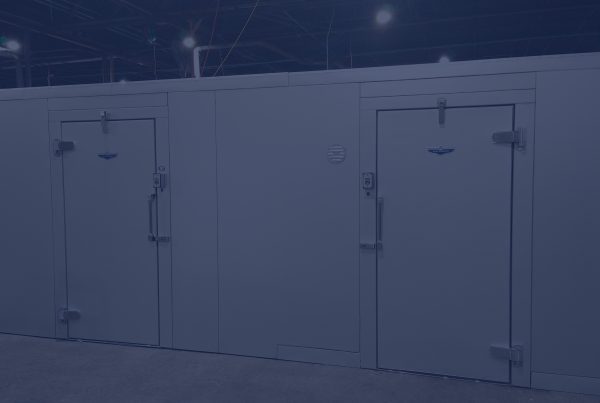Walk-in coolers and freezers are a very custom product. Standard sizes are available in the industry but they assume some standard specifications. Walk-ins are not a one-size fits all item like other foodservice equipment. If you are shopping for walk-ins online, make sure to review the specifications used in sizing that walk-in. Where the walk-in is located geographically as well as if it will be installed indoors or outdoors makes a difference in the required equipment needed to run your walk-in effectively.

U.S. Cooler indoor walk-in cooler without a floor.
Here are some important things to consider before purchasing a walk-in cooler or freezer online.
- Indoor or Outdoor: Indoor and outdoor walk-in coolers and freezers are manufactured differently. Outdoor models require additional weatherproof items on the walk-in. If your walk-in will be located outdoors, it will require some type of weather ceiling strips or a rain roof to protect the panels from the elements. If refrigeration units will be located outdoors, they require a weather cover as well as all-weather controls. An Indoor walk-in will not work properly outdoors without additional equipment. Indoor and outdoor refrigeration units are sized differently. Look closely at the description to make sure it will fit your location needs.
- Floor or No Floor: Whether or not you’ll need an insulated floor depends on where your walk-in unit will be installed. Walk-in freezers almost always require an insulated floor unless you have an insulated concrete floor already in place with thermal breaks. Walk-in coolers do not always require a floor, but it depends on where the walk-in will be installed. For cooler units installed indoors on a bare concrete slab, a floor is not essential. In new construction, if you plan on carrying heavy loads in and out of your walk-in cooler, it is recommended to construct an insulated concrete pad with thermal breaks. This will help stop condensation from forming on your concrete floor. For a walk-in to be placed above-grade level such as over a basement or on a second story floor, an insulated floor is required.
- Holding Product: What you are storing in your walk-in makes a difference in what refrigeration unit is needed. For coolers, many models are sized assuming product entering the cooler will be 55°F and the cooler will be holding at 35°F. For freezers, many models are sized assuming product entering the freezer will be entering at 20°F and holding at -10°F. Models vary, so make sure to check the specifications on how it was sized. If product is entering or holding at different temperatures than what the refrigeration is sized for, the refrigeration will be sized incorrectly causing it to not work properly.
- Airflow around the Walk-in: When planning your space, remember that there should be at least 2” around the exterior of the walk-in for airflow. Without the proper airflow around walk-in cooler or freezer panels, panels could sweat or cause condensation.
- Refrigeration Systems: There are two main types of refrigeration systems used on walk-in coolers and freezers.
- The “pre-assembled-remote” refrigeration is a split system with the coil inside the cooler/freezer and the condensing unit either outdoors or near the walk-in. Most often on remote refrigeration systems the condensing unit is installed outside of the building. Remote refrigeration units require a licensed refrigeration contractor to install and run lines. For refrigeration warranty purposes all refrigeration must be installed by a licensed refrigeration contractor.
- The “self-contained” refrigeration system contains the coil and condensing unit all in one that is installed on the ceiling or on/in the walls of the walk-in. Typically, a hole is pre-cut in the ceiling panel or wall panel and the unit drops in. This unit is usually ready to be installed, however a licensed refrigeration contractor must start up unit.
- Geographic Location: The geographic location where the walk-in will be installed makes a difference. Walk-ins that are located in warmer or colder climates require to be sized accordingly. Walk-ins being shipped to warmer climates, higher elevations or with warm product entering temperatures may need a custom quotation and may not work with a “package” available online. Make sure to check the ambient temperature in the specifications to ensure the refrigeration is sized properly and will suit your climate.
- Delivery: Due to the large product size, walk-in cooler and freezer panels are shipped on pallets and banded together for protection. A forklift will be needed to unload the unit or the unit can be unpacked and unloaded panel by panel off the pallet while it is still on the truck. Two or three people will need to be available to receive delivery if this choice is chosen. You may be charged a surcharge if it takes too long to unload the truck. Many trucks do not have a large enough lift gate for the size of pallets being delivered, therefor this option may not be available for you. It is recommended to have a fork-lift onsite at the time of delivery. It is a good idea to contact the shipping company to make an appointment for delivery to ensure the delivery process goes smoothly. Residential deliveries and limited access locations may incur sur-charges from the shipping company.



